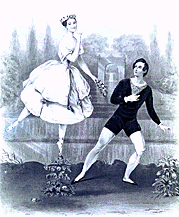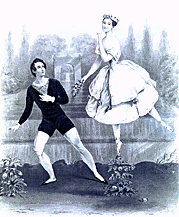
Motivating Questions

Questions:
Historical
1. Who was the first individual to use pointe shoes? Was it a collective
shift or did one person begin the trend?
2. When did pointe shoes first appear? Was there other events occurring
at this time that created an environment that allowed for pointe shoes
and the techniques they made possible to appear and be accepted?
3. How and why were these objects and their associated techniques popularized?
When did it become common to use pointe shoes?
Dance
1. Pointe shoes lend themselves to particular kinds of expressive techniques
for the dancer. What are these techniques and to what ends do choreographers
and dancers use them as a means of expression?
2. How has dance been changed by the invention of pointe shoes? How have
expectations of ballet and dancers changed due to this innovation?
3. Is there a “personality type’ associated with the image
of a dancer en pointe (ex. tempermental, anorexic, etc.)? Has this “type”
shifted over time since point shoes came into use?
Fashion and Clothing
1. What are the similarities and differences that exist between clothing
and costume? How do/did pointe shoes resemble everyday shoes? How did
they differ from dance shoes that existed previously?
2. Why are shoes, in this case, ‘pointe shoes,’ designed with
the paradoxical function to protect/aid and to hurt/harm?
Individual and Society
1. What do pointe shoes and their use say about the individual wearer
and the society in which they are worn and accepted?
2. Why don’t men wear pointe shoes? What about pointe shoes, and the
techniques they give rise to, make them unsuitable for men? Does this mean
that there are issues of gender at work here?
3. Do pointe shoes separate the dancer from the rest of society in a particular
way? Does this separation have gender implications? How do pointe shoes
and the techniques they make possible maintain or undermine prescribed
notions of gender?
4. Why would women, dancer and non-dancers, go through this ritual of pain
regarding the shoes they wear? Do non-dancers take the same amount of pride
in the self-inflicted wounds that come about by wearing "impractical
shoes?" What are the objectives of such a seemingly masochistic undertaking?
5. While not pointe shoes, the images within The Red Shoes may indicate
the presence of some myth that was circulating at the time this story was
written (mid-nineteenth century). The story seems to conflate dancing with
vanity and lack of control and the “dancing” is contained within
the shoes. Did shoes, particularly dance shoes, stand in for something forbidden
and dangerous? What did they say about the person who wore them?
| Motivating Questions |